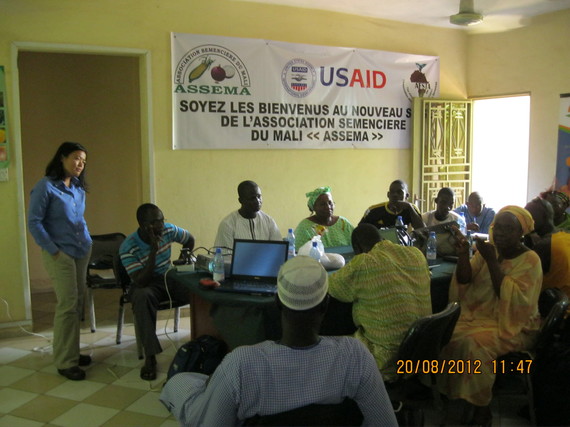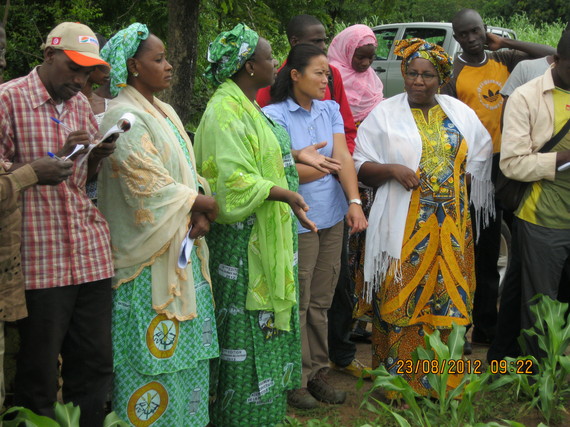One of the first jobs I had after my undergraduate degree in International Agronomy was at Colorado State University in Fort Collins working for a grassroots initiative called the International Biodiversity Observation Year (IBOY).
At that time, the term biodiversity was not well known. Our objective was to raise awareness on issues surrounding the environment by producing newsletters and providing resources for teachers and science museums to teach about biodiversity. In addition, we highlighted work by biodiversity scientists across research topics such as soils, plant biology, ecology and marine biology.
Over a decade later, my interest in biodiversity is strengthened by my work in plant breeding. When I celebrate the International Day for Biological Diversity (IDB) now, it is with a deeper understanding of the ecosystem services that biodiversity provides, like genetic diversity in the food we eat and soil formation, for example. #IAmAScientist because, as a plant breeder in field research, I have the opportunity to help farmers improve their lives and the lives of others through discovery and improvements to advancements in technology for sustainable development.
Plant breeders have been studying genetic variation and plant diversity since time immemorial. They breed plants for improved performance and adaptation to a natural environment. Today, as we consider ways to mitigate climate change, incorporating genetic diversity is absolutely necessary. Advancements in science like biotechnology have paved ways for doing this faster and smarter, making the goals of improving livelihoods and ensuring food security achievable.
This year's theme for the IDB is Biodiversity for Sustainable Development. More and more people are recognizing the need for continued advancements in technology like sequencing genomes and using that information for selecting the best plants to withstand tough growing environments. Terms such as climate-smart agriculture and an eco-modern manifesto are reflecting a new paradigm that is essential for food security - agricultural intensification. The mantra is to increase productivity on the farmable land we have now in order to sustain humanity and at the same time prevent the conversion of rainforests into farms --thereby benefiting the environment.
Yield gains for corn production over the past 100 years have demonstrated how concentrated efforts in agricultural improvements can change lives. Since the 1930's, hybrids have leveraged the genetic information of plants for a significant yield boost. Since the 1990's, biotechnology has enabled substantial reduction in pesticide chemical sprays. Agronomic practices like integrated pest management strategies have also played an integral part in the success developed countries have achieved in increasing production.
As we wait to see what climate change will deliver, the predictions are frightening. They call for extreme challenges for growers all over the world, and especially in developing countries, where poverty, hunger and malnutrition are already prevalent. Smallholder farmers in developing countries, many who are women, need access to advances in technology such as certified hybrid seed, disease resistant seed varieties, and training in improved management practices.
Many farmers in developing countries are still using open-pollinated seed varieties and old farming practices, garnering a modest return. Their average harvest is equivalent to what U.S. farmers looked forward to almost 80 years ago. For example, in the U.S., the average yield for corn in the early 1900's was about 25 bushels per acre. Fast forward to 2012, and the average yield in the U.S. was about 155 bushels per acre. Imagine, an estimated difference of 125 bushel per acre that farmers in developing countries do not have access to. The productivity gap -- as measured by seed yields, a source of wealth for a farmer -- is unacceptable. We must allow for advances in science to enable smallholder farmers to close this gap and take part in a global market. In doing so, they can achieve growth and prosperity.
History has shown that poverty and famine can lead to war and civil uproar. Indeed there are factors out of the control of a scientist like myself. I do not have power to sway politics, nor funding to build roads necessary to get harvests to market, but I can play a role in capacity building by sharing the science and by helping to bring farmer yields and income to new heights.
I saw firsthand the role of technology in Mali through the United States Agency for International Development Farmer-to-Farmer technology transfer program and the nonprofit Winrock International. Working with host organization Faso Kaba Seed Company, I met with local seed producers, plant breeders, and smallholder farmers to learn more about their processes and challenges. Many Malians came to learn about how to make hybrids in maize and sorghum, which are important cash crops for the region. To increase their harvests, Malian farmers are also looking at cooperatives and conventionally bred drought-tolerant maize. Agronomy students who participated in these training session were extremely passionate about becoming the next generation of leaders in their country. They were excited by the opportunity that quality seed could bring to their family farms. They were also faced with a similar challenge in raising awareness of the need for change in their current farming practices. They understood that they needed to work hand in hand with the older farmers, showing them that new ways of farming could help them reap more benefits. I was inspired by these young students, and I was honored to play a part in their education by teaching all I knew about how to make yield gains through plant breeding.
By far, I'm not an expert in world economy, nor do I understand all facets of the value chain. I cannot promise that a similar magnitude of increase in yield gain is possible in other parts of the world or in other crops. What I do stand behind is that we can and we should use advancements in science to improve a farmers chance to yield a meaningful return. We can share knowledge on plant diversity and genetic variation. We can share approaches to finding genes for specific benefits like disease resistance or drought tolerance. We can help make the best plant selections adapted to their specific growing environments.
As I sit in my comfortable chair in the U.S. with plenty of food in my home, preparing for another Farmer-to-Farmer volunteer trip to East Africa this summer, I often stop to wonder: Is there adequate access to quality seed where I'm going and in places like it? Can next-generation plant breeding become a common practice in places that need it most and at pace with climate change? Will climate change dash hope?
For those of you that celebrate IDB, I celebrate with you. Let's raise awareness of the crucial importance of biodiversity in agriculture and the advances in agriculture that have allowed farmers to improve their lives. Moreover, let's promote the technology and access to it for smallholder farmers, so that developing countries can get out of the poverty trap and feed themselves in ways that are more sustainable for the environment.


